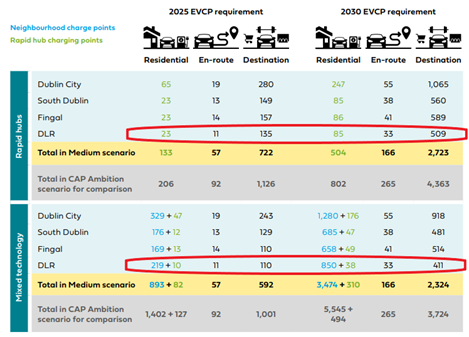Dublin
Challenge
How can we safely provide EV charging for residents without driveways, integrating infrastructure seamlessly with public footpaths while meeting health and safety standards?
CURRENT SITUATION
In 2020, the four Dublin Local Authorities commissioned a study on Dublin’s EV charging needs through 2030 to align with government targets on EV uptake. Published in 2022, the study outlined that Dublin’s local authorities will focus on neighbourhood charging for residents without off-street parking and support commercial installations of charging hubs and rapid chargers for residential developments, en-route, and destination charging. For Dun Laoghaire-Rathdown (DLR), combined slow and rapid charger requirements were estimated at:

Currently the number of neighbourhood charging units controlled by DLR is under 30, with no rapid chargers installed as of November 2024.
On the neighbourhood level, residents who live in terraced houses or buildings without private driveways or garages, lack options for at-home EV charging, as any setup would require crossing public footpaths with charging cables to public parking spaces. This creates health and safety concerns, as well as trip hazards, making the adoption of EVs more challenging for these residents. Currently, the absence of suitable charging infrastructure in these areas can disincentivise EV ownership, limiting the town’s overall EV adoption rates and slowing progress toward sustainable urban mobility.
The city is keen to explore solutions that would allow residents to access safe and convenient on-street EV charging without requiring significant new infrastructure installations, especially in dense, residential areas where public space is limited.
Solutions should not include leveraging existing street furniture, using retractable or covered cable systems, but may include introducing new on-street charging units specifically designed for high-density, footpath-centric neighbourhoods. Solutions should prioritise safety, accessibility, and scalability to other similar urban areas, with a minimal impact on pedestrian movement and public space aesthetics.
Desired situation
- Measured interest in EV adoption based on charging improvements.
- Reduction of EV Charging cables crossing public footpaths.
- Number of community members engaged in the pilot via feedback or surveys.
- Utilisation factor for the charging units – above 25% will show significant local requirements and uptake.






